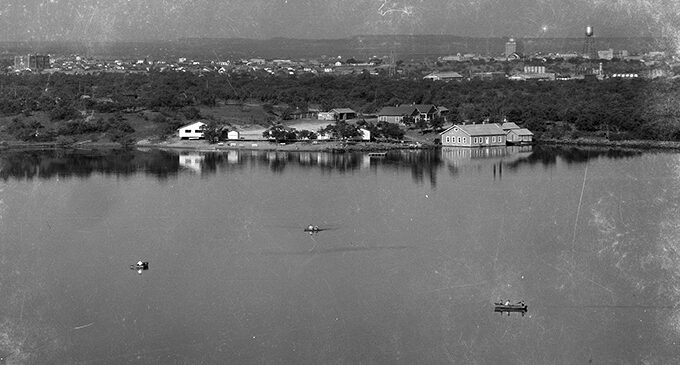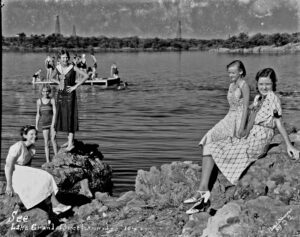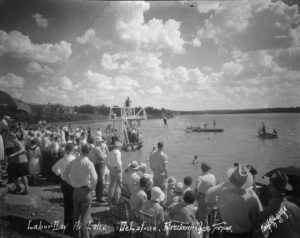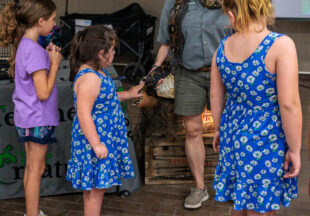Stephens County Chronicles: Breckenridge area has rich lake history

By Jean Hayworth/Breckenridge Texan
Most current residents are familiar with Hubbard Creek Reservoir (aka Hubbard Creek Lake) on the west side of Stephens County, as well as Possum Kingdom Lake, a small portion of which is in the northeastern corner of the county, but many are not aware of the historic Lake Grand, which is still in existence. Additionally, through the years, there were other lakes built in the county.

Jean Hayworth
Located just east of town off of what is now known as Lake Grand Road, Lake Grand was created as one of the first water sources for Breckenridge. At one time, it was about nine square miles in size.
The Swenson Memorial Museum in Breckenridge has photos taken in the early 1920s of the swimming activity at Lake Grand. It was reported that men would drive their horse-drawn wagons out to the lake to fill up their water barrels. According to a 1964 report from the Texas Water Commission, Lake Grand was built in the early 1920s for mining, irrigation use and standby municipal supply. However, the report states, the lake became contaminated with salt water soon after it was constructed and it eventually became used for storing salt water.
Then, there is Lake Daniel, which most local residents are aware of for fishing. It is located southeast of Breckenridge off U.S. Highway 183 South, on FM Road 145. It was created in the late 1940s and is 950 acres in size, fed by the Gunsolus Creek and is reportedly 42 feet deep at the deepest spot when the lake is full. Lake Daniel was formerly host to the Southern Drag Boat Races in mid-July, as part of the Summer Nationals.

A group of young women enjoy relaxing on the rocky shore of Lake Grand, while a group of boys uses a platform in background for diving and jumping into the water. Some of the oil wells of Stephens County can be seen in the background of this 1932 photograph. (Photo by Basil Clemons/Courtesy of the Basil Clemons Photograph Collection, University of Texas at Arlington Libraries)
Other lesser known lakes were dug by families over a period of years. One of the largest family lakes is the Dye Lake or sometimes known as the H. Graden Dye Reservoir. Johnny Dye dug the lake with a mule and plow over a 10-year period. Originally, the lake was 18 acres, but over the years, family members have expanded it to 35 acres. It is located about five miles southwest of Breckenridge off Highway 183 South, on FM Road 152. It is also fed by the Gunsolus Creek.
Another minor lake in the county is Lake Necessity, which is located six mile southeast of Breckenridge, off Highway 183 South, on FM Road 143 to County Road 144. It was reportedly 16 square miles when it was first constructed.
The Blackburn Lake, now known as the Jimmy Dye Lake, is also located southeast of Breckenridge and fed by the Gunsolus Creek. It is only eight to 10 acres in size and is now on private property.

A crowd of onlookers observes people swimming at Lake DeLafosse near Breckenridge in 1931. The photographer Basil Clemons captioned the picture, “Labor Day at Lake de La Fosse, Breckenridge, Texas.” (Photo by Basil Clemons/Courtesy of the Basil Clemons Photograph Collection, University of Texas at Arlington Libraries)
Another recreational lake, DeLafosse Lake, was constructed by the combined efforts of residents of Albany and Breckenridge. It is currently located half way between the two towns. It was a private country club for members only. DeLafosse Lake was a popular hang-out in the 1950s through the 1970s. Lake DeLafosse is now on private land owned by the Jones brothers of Albany. The lake is approximately 100 square acres.
Due to the great droughts of the 1950s in this part of Texas, an alternative source for water was explored in the area, headed by Carter King of Albany and Hook Slemons of Breckenridge, who was mayor of Breckenridge, at that time. Of course, I am speaking about Hubbard Creek Reservoir and how it came into reality. Representatives from Abilene, Albany, Anson and Breckenridge began to meet as early as 1951 and began planning for the body of water that would be a source for the four towns.
The West Central Texas Municipal Water District was established in 1951 with representatives from the four towns.
The State Board of Water Engineers issued a permit to the WCTMWD on Aug. 9, 1957, for work to begin on Hubbard Creek Reservoir. That permit was amended June 23, 1959, to enlarge the original plan. Actual construction began March 1, 1961, and was completed when the dam was finished on Nov. 26, 1962.
The reservoir filled up much more quickly than anticipated, due to some late fall and early spring heavy rains. The storage capacity for the reservoir, at maximum, is 318,174 square feet at the elevation foot marker at 1,183. There are nine gates on the dam that can be opened to run off excessive water that rises above the 1,183 foot marker. There have been a few occasions when we received a deluge of rain in a very short period, which caused catastrophic flooding in the low areas of Breckenridge and Stephens County, such as in 1981 and 2015. The Gunsolus Creek has come up over her banks east of town, at the small bridge, among other low places in Breckenridge. In 1981, 21 inches of rain fell in a 24-hour period.
Due to a recent drought, the Hubbard Creek Reservoir is only 52 percent full. Just three months ago, it was 62 percent full and last year at this time, the lake was 71.8 percent full.
Hubbard Creek Reservoir is fed by Hubbard Creek, Sandy Creek and Brushy Creek. It is owned and operated by the WCTMWD.

A group enjoys a picnic at Lake Grand in 1932. The lake was built in the early 1920s. (Photo by Basil Clemons/Courtesy of the Basil Clemons Photograph Collection, University of Texas at Arlington Libraries)
Cutline, top photo: Boats can be seen in the foreground and the city of Breckenridge in the background of this undated Basil Clemons photo taken at Lake Grand. (Photo by Basil Clemons/Courtesy of the Basil Clemons Photograph Collection, University of Texas at Arlington Libraries)
Jean Hayworth is a columnist for the Breckenridge Texan, writing about the history of Breckenridge and Stephens County. Originally from Pennsylvania, she’s lived in Breckenridge since 1975. Hayworth is a veteran of the U.S. Navy, as well as a former school teacher and newspaper reporter/editor/columnist. She also works part-time for the Swenson Memorial Museum in Breckenridge. Click here to read more about her and the beginnings of this column.































































































